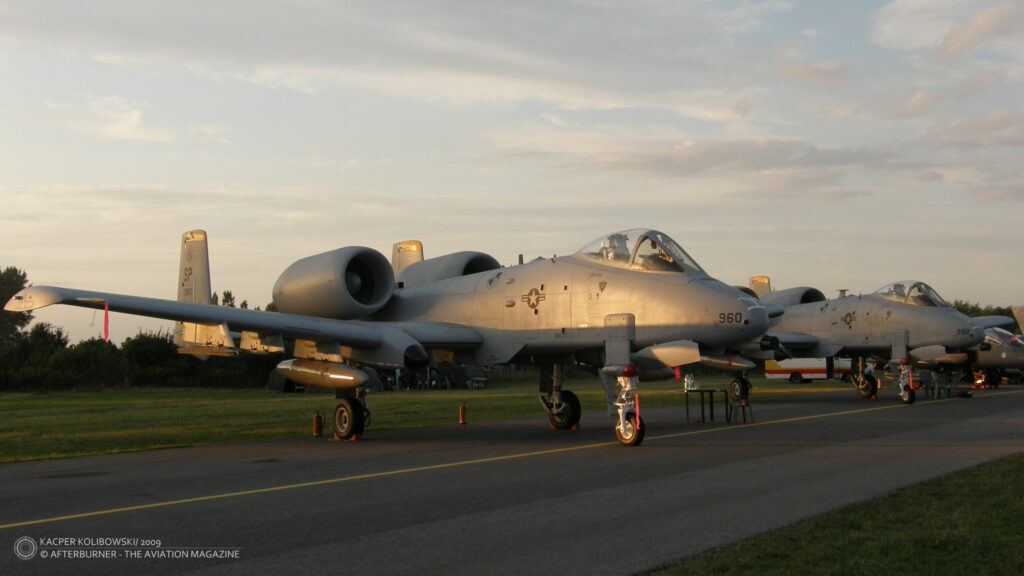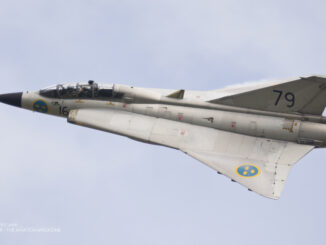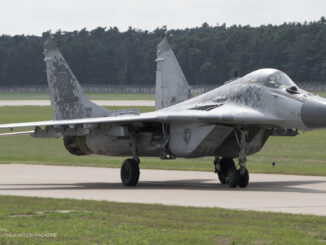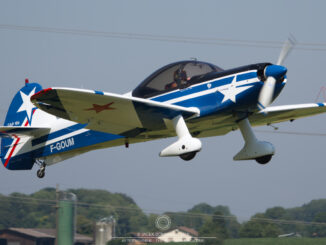 Pair of Fairchild Republic A-10 Thunderbolt II (c/n 0665 and c/n 0687, respectively 81-0960 and 81-0992 of the 52nd Fighter Wing, United States Air Force), static display at Międzynarodowe Pokazy Lotnicze AIR SHOW 2009 (International Air Show Radom 2009) in Radom, August 2009.
Pair of Fairchild Republic A-10 Thunderbolt II (c/n 0665 and c/n 0687, respectively 81-0960 and 81-0992 of the 52nd Fighter Wing, United States Air Force), static display at Międzynarodowe Pokazy Lotnicze AIR SHOW 2009 (International Air Show Radom 2009) in Radom, August 2009.
The A-10 Thunderbolt II, popularly known as ‘Warthog’, is an aircraft that – during its almost fifty years of operational service with the United States Air Force – became the true icon of Close Air Support (CAS). Although we have already detailed the history of this aircraft in one of our articles published in 2022, it is worth to briefly outline its story once again. And another deployment of the A-10 Thunderbolt II aircraft to Europe makes just the perfect opportunity to do so.
These days, ten A-10 aircraft from the Air Force Reserve’s 442nd Fighter Wing from Whiteman Air Force Base, Montana are deployed to the Old Continent and are operating from Zaragoza Air Base in Spain and Thessaloniki Air Base in Greece. The recent deployment of ´Warthogs´ to Europe is organized within the framework of DEFENDER 2023 exercise, a joint multinational military training activity intended to build readiness and interoperability between US and NATO allies.
History of the ‘Warthog’ dates back to the mid-1960s. The aircraft was developed within the A-X (Attack Experimental) programme announced by the USAF in 1966, in response to the lack of effective CAS aeroplane in the early stages of the Vietnam War. The main reason was that Douglas A-1 Skyraider, the main close air support aircraft still in use at the time by the USAF and US Navy for the abovementioned task, proved to be already too slow and obsolete.
Initially, there was a plan to replace the Skyrider with F-4 Phantom II, F-111 Aardvark or A-7 Corsair II jets, however none of those aircraft turned out to be suitable for the task. Therefore, it was clear that a new, dedicated CAS aircraft was needed.
Through evaluation of designs submitted within the aforementioned A-X programme by as many as twenty-one aviation companies, only two of them – YA-9 by Northrop and YA-10 by Fairchild Republic – were chosen for the ultimate stage of the programme. And it was Fairchild Republic, that finally became the main contractor entrusted with the development of the new CAS aircraft for the USAF.
The YA-10 prototype flown for the first time on 10th May 1972, and just four years later, the aircraft – already officially designated the A-10 Thunderbolt II – entered operational service with the USAF. Nevertheless, the aircraft had to wait a long time of fifteen years to open its combat record. Only in 1991, the A-10s were deployed to the Gulf War and played the key role in destroying enemy tanks and many other ground targets.
Since then, the ‘Warthog’ was used in conflicts around the world, particularly during the recent wars in Afghanistan and Iraq. Due to its effectiveness in providing close air support to ground units, the aircraft earned its reputation as one of the most important aircraft in the USAF inventory.
The A-10 owes its almost legendary combat effectiveness to its unique design. The aircraft was developed as heavily armoured and armed, with the ability to operate at low levels. Therefore, its straight wings and two turbofan engines mounted on top of the rear part of the fuselage, as well as its twin tail, provide the ‘Warthog’ truly exceptional manoeuvrability and stability at low altitudes. The fuselage armour, which includes so-called ‘titanium tub’ that protects the pilot and critical components of the aircraft, allows it to withstand significant damage by ground fire and continue its mission over enemy territory.
However, the greatest asset of that ‘flying tank’, which the A-10 certainly is, affecting its operational effectiveness and making it the truly iconic and so highly recognized aircraft is its armament. More specifically the 30 mm Gatling gun GAU-8/A Avenger with theoretical rate of fire of 3,900 rounds per minute, able to destroy virtually every ground target. Half-jokingly, half seriously, the A-10 is actually an aircraft that was built around that Gatling gun. What´s more, the ‘Warthog’ can carry quite a wide range of missiles and bombs, making it highly versatile in a variety of combat scenarios.
During its many years of service, the A-10 became known as the aircraft that can be fully relied upon when it comes to CAS during combat operations. However, despite its success and appreciation from ground troops, the ageing ‘Warthog’ struggled with some problems. As a result, several attempts were already made to withdraw it from active service, and to replace the A-10 with a newer, more advanced aircraft. In recent years, with implementation of F-35 Lightning II aeroplane into service, calls for retiring the ‘Warthog’ reappeared.
However, the extraordinary capabilities of the A-10, its reliability in performing assigned tasks and the reputation this aircraft earned over the years of service – not mentioning the fact that, in comparison to many newer and more advanced aircraft, its operation costs are incomparably lower – make the ‘Warthog’ to be still irreplaceable CAS jet and it does not seem the A-10 is going into retirement so soon.
A direct consequence of the above is that, four years ago, the USAF decided to upgrade avionics and armament of the A-10 aircraft extending their service life. With this modernization, the ‘Warthog’ is expected to remain in service until at least 2030.
Although, for many years, the ´Warthogs´ were permanently based in Europe, now they are just visiting the Old Continent within special deployments or large military exercises. Therefore, they are a rare visitor of the European air shows.
For the first time, the A-10 Thunderbolt appeared in Europe with the 81st Tactical Fighter Wing, activated in October of 1978 at RAF Bentwaters station. The unit initially consisted of three squadrons but later their number was doubled. The 81st TWF used to operate rotating forward detachments of the ´Warthogs´ at four air bases in West Germany.
In 1992, the A-10s were reassigned to the just reactivated 52nd Operations Group at Spangdahlem Air Base in Germany, where they stayed until 2013 – the date the ´Warthogs´ were withdrawn from Europe.
Nevertheless, it was just a short pause as the A-10s returned to Spangdahlem in 2015 and were based there for six months. The aircraft were assigned to the 355th Fighter Wing USAF and their deployment was related to Operation Atlantic Resolve, aimed at reassuring NATO allies in Europe about the US commitment to collective defence, as well as building peace and stability in the region in the face of the crisis in Ukraine that arose in 2014.
Since that time, the ´Warthogs´ are returning to Europe from time to time and participate in main USAF and NATO military exercises there. In May and June 2022, the A-10 aircraft from Maryland National Guard were deployed to Europe for the DEFENDER 22 exercise and operated from Norway, North Macedonia, Latvia, Lithuania, Poland and Estonia. And now, they are taking part in this year’s, already mentioned, edition of the exercise.
In 2009, two of the A-10 Thunderbolt II aircraft from Spangdahlem visited Międzynarodowe Pokazy Lotnicze AIR SHOW in Radom, during which our Photo of the Week was taken. That was the first and, so far, the only time the ‘Warthogs’ took part in an air show in Poland. Although they could be seen only at static exhibition of the air show, the A-10s attracted a lot of interest from visitors to the event.



